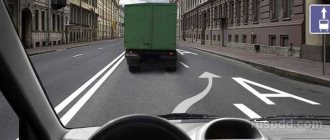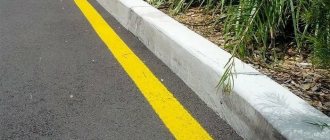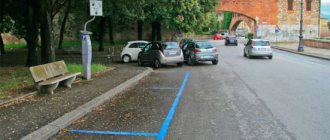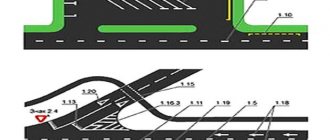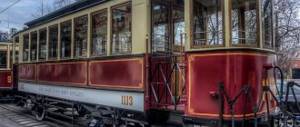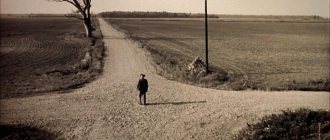On February 20, 2021, GOST R 51256 “Technical means of organizing road traffic” was adopted. Road markings. Classification. Technical requirements". The document comes into force on June 1, 2021. This GOST establishes requirements for road markings.
- New road markings;
- Safety island;
- Yellow markings;
- Road markings are blue;
- Orange markings;
- When will the new markings appear on the roads?
Let's consider the part of the standard that is of interest to road users. New types of markup have been added, for some types of existing markup it is possible to use yellow color, and blue color has been added for markup 1.7.
New road markings
Tram station
New road markings 1.17.2 - tram stops
A new type of markings 1.17, indicating stopping places for route vehicles.
Stops for trackless vehicles are indicated by markings 1.17.1 - new marking number 1.17; for tram stops with tracks located in the center of the road, markings 1.17.2 have been added. It is applied on the roadway on both sides, has a width and pitch of 1 meter. Currently not included in the Traffic Rules.
Waffle iron
- A new type of road marking 1.26, which has already received the unofficial name “Waffle Iron”.
Road markings 1.26 - waffle iron
1.26 (color - yellow) - designates a section of the intersection that is prohibited from entering if there is a traffic jam ahead along the route that will force the driver to stop, creating an obstacle to the movement of vehicles in the transverse direction, with the exception of turning right or left in the cases established by these Rules. The marking can be used independently or in conjunction with road sign 1.35.
Amended to the Traffic Rules from April 28, 2021.
U-turn
Added image of marking 1.18, indicating a turning lane.
Turn lane
Check out all the images of the new road signs.
Red markings on the road what the traffic rules mean and what the fine is 2021
In most cases, it comes in the usual white color. These markings divide the roadway into traffic lanes and mark the edges of the road. Depending on the situation, the line can be solid or broken.
The first one, as you know, cannot be crossed. Well, the most serious fines are issued when vehicle drivers make any maneuver through a double solid line.
White markings also mark pedestrian crossings and stop lines, including those in front of traffic lights.
Not so long ago in Russia, along with the traditional white road markings, new lines appeared on roads - yellow and orange.
Some drivers, especially those who had not been familiar with traffic rules updates for a long time, were simply baffled by them. Let's take a closer look at what the yellow and orange markings on the road mean.
Do not forget that ignorance of traffic rules is not only fines, but also a direct threat to other road users.
What do the red markings on the bicycle road before the bus stop mean?
If a minibus leaves the route, for example, to avoid a traffic jam, it loses the right not to follow these signs. We quote the Russian Federation Traffic Regulations: 3. Prohibition signs The signs do not apply: 3.1 - 3.3, 3.18.1, 3.
18.2, 3.19, 3.27 - for route vehicles; Here we are talking about the following road signs: 4. Mandatory signs The validity of signs 4.1.1 - 4.1.6 does not apply to route vehicles.
In the coverage area of marking 1.17 in combination with the signs “Bus and (or) trolleybus stopping place” (5.16) and “Tram stopping place” (5.17), it is prohibited: firstly, to make a U-turn and reverse; secondly, to stopping and parking of vehicles (as well as at a distance of 15 meters before and after the marking site).
What do yellow markings on the road mean according to traffic rules?
Zigzag markings are applied at the edge of the roadway, as well as in the middle of the road if we are talking about a tram. Depending on its length, one or more vehicles will be able to stop at the same time. Failure to comply with the rules established in connection with the broken line will subject the driver to penalties.
On the territory of the Russian Federation, yellow markings in the center of the road can be applied using any materials that meet the established requirements: paint, thermoplastic, polymer tape that does not protrude more than 6 mm above the road surface. GOST sets the coefficient of adhesion to the surface (25%), as well as the durability of the coloring material (from 6 months).
What do red markings on the road mean?
Therefore, if you are caught under Article 12.15.4, it is best to agree with the traffic police officer and give him your license. And then, during the analysis, “repent” to the inspector. In extreme cases, you will be sent to court.
But unlike traffic police officers, judges are more loyal to those who plead guilty and impose the minimum punishment - a fine. But if you are firmly convinced that the rules were not violated, and the protocol was drawn up unfairly, start the “war” from the very first minutes.
In the protocol, in the column “Explanations of the violator,” write: “Did not violate traffic rules, qualified legal assistance is required.” Next, make a complaint (either with the help of a lawyer or on an online forum) and register it with the traffic police department.
A response to a complaint is required to be given within 10 days, but in reality it takes up to a month.
But the court has only two months from the date of violation to deprive you of your rights. And then there is a high chance that the case simply will not be considered on time. Pavel (Jaja) Yuri Kornilov, you are a little wrong. if the protocol is drawn up according to Part 4 of Article 12.15, then it does not go to any analysis group - the material is immediately sent to the court. in court - imprisonment for 4-6 months. for part 3 of the same article - a fine of 1000-1500 is imposed by the unit commander (or a judge, if part 4 is reclassified to 3 in court)
What are the markings on the road according to traffic regulations?
More attention should be paid to the drawing itself. If it is solid red, you are not allowed to cross it. Traffic participants also have nothing to do with the median marking, because it divides the road into sections intended for different directions. Road services can use red paint in the absence of orange.
- 1.1 limits lanes intended for traffic in opposite directions. Naturally, you can’t cross it; this will be driving into the oncoming traffic.
- 1.2 is applied to mark the boundary of the roadway. Driving outside of it is prohibited. It is also forbidden to drag the wheels while driving. But according to traffic regulations, a solid marking line at the edge of the road can be crossed to stop a vehicle. The same is permitted when leaving the roadside to continue driving.
- 1.3 are never crossed. A double solid line demarcates the flow of oncoming traffic on a multi-lane road.
- 1.4 means it is prohibited to stop at this place. It is painted in yellow.
- 1.11 consists of a dotted line and a solid line, running close and parallel. Applied to separate traffic lanes. You can cross it from the side of the broken line. And from a solid one - only when overtaking or bypassing an obstacle is completed.
- 1.12. It is allowed to cross it. But only after stopping in front of this lane.
STOP sign or driving without stopping is prohibited
According to traffic regulations, a red sign is installed near unregulated intersections, i.e. those without traffic lights.
These are places where main and secondary roads intersect, T-shaped intersections, areas where visibility is limited for the driver.
Usually the “STOP” sign is accompanied by a special marking - a stop line. Drivers must comply with the following rules:
A “STOP” sign on a white background is installed near unregulated and controlled pedestrian crossings or traffic lights and unregulated railway crossings. The symbol informs that the motorist may not stop in this place, except when there is a pedestrian at the crossing or the traffic light is prohibited.
What do red markings on the road mean?
Yury (Saveria) Driving into the oncoming lane The traffic rules describe four cases prohibiting driving into the oncoming lane: Yury (Saveria) Cases often arise when the markings on the road are erased or covered with snow. As a result, it turns out that the car crosses a double solid marking line.
Such a line informs the motorist about the edge of the roadway, and it is prohibited to cross it; ·The dotted stripe with similar intervals and strokes informs about the traffic lanes at the intersection; It is a line in which the strokes are 3 times the distance between the dotted lines. She informs that there is a continuous road nearby that divides the roadway into different traffic flows; · Stripe in the form of strokes.
Yellow marking line along the roadside and curb
- 1.4 - a solid line, which is mainly applied at a short distance (10-20 centimeters) from the curb or roadside. Its presence indicates that stopping in this area is prohibited. It may indicate the coverage area of sign 3.27. Thus, you cannot stop at the allocated interval, much less leave the car for longer than 5 minutes;
- 1.10 - dotted line. Warns the driver that parking is prohibited on the marked section of the roadway (in addition to or placed separately from sign 3.28);
- 1.17 - zigzag line. It is painted on the asphalt where route vehicles stop to transport passengers or taxis. According to traffic regulations, parking here is also prohibited.
- white - constant, with its help most of all symbols are applied - solid, dotted, dividing stripes, zebra, stop line, etc.;
- orange - temporary, if you see it, it means that road work is underway somewhere nearby and you need to be guided by the requirements of the orange lines;
- yellow is also a permanent one, it is used solely for the sake of convenience and good visibility, it is applied in most cases in the area of bus stops.
What do yellow road traffic markings mean?
What do yellow road markings mean? According to traffic regulations, yellow road markings 1.4, 1.10, 1.17.1, 1.17.2, 1.26 are also permanent. It’s not difficult to remember: there are only three types of yellow road markings, namely: a yellow solid line, a yellow broken line and, finally, a yellow zigzag line .
For those who are not in the know, the markings come not in two colors, as some believe, but in three colors: white, yellow and orange. In general, it can be said that such variety is used more for convenience than for any other purpose . So, the orange road markings are temporary.
Yellow curbs and shoulders, which means yellow markings on the road
The yellow zigzag stripe 1.17 along the edge of the road determines the stopping place for shuttle buses and taxis. Its length should not be less than the landing area itself, and is determined by the number of cars stopping or already standing at the same time.
What does the yellow stripe on the side of the road mean? It is applied along the edge of the roadway outside the city limits. In this case, crossing it, stopping or parking nearby will violate the restrictions imposed on traffic on the side of the road. Further, where the markings are interrupted, you can park the car.
08 Feb 2021 juristsib 317
Source: https://sibyurist.ru/vozniknovanie-prava-sobstvennosti/krasnaya-razmetka-na-doroge-chto-oboznachaet-pdd-kakoj-shtraf-2021
Safety island
The markings 1.16.1 - 1.16.3 indicating guide islands have been corrected. Markup 1.1 is excluded from the image. Now we can say for sure that the island is limited by marking 1.1, and the designation 1.16.1 - 1.16.3 is applied inside this island. Previously, there was an ambiguous understanding of the use of such markings and questions remained regarding the qualification of offenses.
| Was | From June 1, 2021 |
Blue markings
One of the exciting questions is: “Is it true that there will be blue markings on the roads?” Yes its true. This is marking 1.7, indicating traffic lanes within the intersection. If there are many directions of movement at an intersection, then the white color becomes motley and can only be visually confusing. Blue color seems more optimal for these purposes.
Blue markings 1.7
Why do we need yellow markings on roads?
There is nothing in the traffic rules that was done just for fun or for beauty. Especially when it comes to road markings. For a second, it is the most effective tool for regulating relations between motorists and pedestrians. Yellow markings occupy a special place in the rules today. There are three schemes in which yellow is used as a mandatory color. In another, yellow is the recommended color. What are we talking about?
Single yellow solid line
Yellow solid single is road marking 1.4. This is applied to the edge of the roadway. It can be applied to the road itself, to the curb, or even to the edge of the sidewalk. This line indicates a ban on stopping and parking of vehicles. In some cases, the markings can be “reinforced” by installing sign 3.27 “Stopping is prohibited” (in this case, the sign is valid until the yellow markings end). The only exception to the marking ban is when stopping special vehicles.
Liability: violation of the yellow solid ban is punishable by a fine of 1,500-3,000 thousand rubles and evacuation of the car to the impound lot.
Single yellow broken line
The yellow broken line is road marking 1.
Responsibility: for violation of parking rules, a fine of 1000-3000 thousand rubles with confiscation of the car to the impound lot. For failure to give priority to a car leaving from 1.10 - a fine of 500 rubles.
Single yellow broken line (zigzag)
The yellow zigzag is correctly called road markings 1.17. It designates the stopping area for route vehicles, as well as the parking lot for passenger taxis. All unauthorized vehicles do not have the right to stop and park on the marking, as well as 15 meters before it begins and after it ends. Exceptions are allowed from the last paragraph, namely, boarding and disembarking and loading and unloading vehicles, provided that it does not interfere with taxis and route vehicles. Also, in the zigzag zone, it is prohibited to turn and drive in reverse. Vehicles leaving the markings accordingly have priority.
Liability: for incorrect parking or stopping, fines range from 1,000 to 3,000 rubles. For failure to provide an advantage - a fine of 500 rubles.
Yellow zebra
Yellow stripes on zebra crossings are an optional but desirable feature that is used to improve the visibility of road markings. In the rules it is numbered 1.14. The rules that apply to yellow zebra crossings for pedestrians are no different from the rules that apply to regular markings without yellow stripes.
Liability: for violating the rules of parking and stopping at a zebra crossing, a fine of 1,000 to 3,000 rubles. For violating the rules of overtaking and turning at zebra crossings - a fine of 500 rubles. For failure to provide an advantage to pedestrians - a fine of 1,500 rubles. Violation of the rules for overtaking on this marking will result in a fine of 5,000 rubles or deprivation of rights for 4-6 months. In case of repeated violation, the deprivation of rights is already 12 months.
Did you like the article? Subscribe to the channel to stay up to date with the most interesting materials
Source
